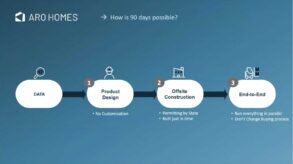
Modular construction was all the rage in the middle of last decade when groups like Japan-based Softbank sunk more than $2 billion into modular builder Katerra and Google’s Sidewalk Labs announced a $1.2 billion plan to build a massive new neighborhood in Toronto with mass timber construction. Unfortunately, those efforts along with a host of other modular startups have met their demise in the past several years, dampening the venture community’s enthusiasm for investing in modular and offsite construction startups.
Despite the high-profile business failures, everyone from industry veterans to presidential economists have pointed to increasing the offsite assembly of building components as key to addressing the availability, affordability, quality and performance of buildings. So, harnessing the lessons of past experiments, a new generation of modular companies is taking shape and seems poised to find more success in the more sober, post-Katerra, post-zero interest rates environment. The players are diverse, and they are leveraging approaches that may yield better opportunities for better outcomes.
One firm that exemplifies the new generation of builders is Mountain View, California-based Aro Homes. We had the opportunity to sit down with Aro co-founder Scott Voulgaris on a recent visit to the Bay Area. Aro has raised $21 million in a round led by Bay Area investor Innovation Endeavors.
Taking the Tesla Approach to Modular
When asked about the company’s approach, one thing Voulgaris quickly points out is the sleek, simple design of its product – and the fact that, right now, it basically only has one product. A critically important thing to know about the modular or “offsite” construction sector is that it is far from monolithic. Modular building companies are pursuing strategies to provide everything from key components of buildings and infrastructure to full buildings, and their products are aimed at different building types such as single-family, multi-family, hospital, hotel and other types of structures. Flexnode, a company that recently raised $9 million is focused on data centers, for example.
Each of these types of structures represents multi-billion segments of the construction market. Further, there are low, medium and high-end segments of those markets. However, in the effort to pursue projects, much like traditional builders pursuing “backlog,” there can be a strong pull to chase an increasingly wide variety of product types too soon.
So, like Tesla, rather than coming out of the gate with a business that could build every type of car and truck on the road, Aro is focusing first on what might be considered the housing equivalent of the Tesla Model S. It is a high-end design, high performing, luxury home that can accommodate up to five beds and should, therefore, appeal to the kind of affluent consumer that might similarly be interested in a highly designed, high performing and spacious vehicle.
By laser-focusing on this particular type of client, Aro hopes to be able to refine its design, supply chain, production and land acquisition efforts to meet this demand in a potentially significant, lucrative part of the market and then expand gradually to other product types that might also be more affordable to a larger consumer base.
The Subtle but Important Advantages of Horizontal Integration
Having recruited several past members of Katerra to its team, Aro, is following a different strategy from the one Katerra followed in one other key respect – Aro is acting as its own developer. Other modular firms such as Blokable, Assembly OSM and Inherent Homes have also pursued developer/builder approaches to a greater or lesser extent. However, Aro seems truly to have embraced ownership of the land selection, acquisition, and permitting process as a key area of competitive advantage.
By serving as its own spec developer, Aro is able to prequalify land sites and only pick the sites that are optimized for its product. Unlike in other manufacturing environments, buildings are constrained by the fact that no two land sites are identical. So, what works on one site may not work on another for a host of reasons. By retaining the ability to choose sites that best fit its prototypes, Aro can maintain much greater consistency in the product, allowing the company to better focus on becoming supremely efficient at creating its home. Also, because Aro has direct data about its consumer demand, it can develop systems to help it optimize the sites it picks for constructability, permitability and salability.
BuiltWorlds Members:
Click Below to Watch Aro Homes’ Demo Presentation Recording
Homing in on Speed to Market
Another key to Aro’s formula is its ability to streamline the permitting process with its standard prototype and then also, because it is both the developer and the builder, to begin production of the home without having first to go through a contracting process with a third party builder. Learning how to compress schedules by running parallel processes, which traditionally are run in series, and by eliminating time traditionally required to develop and permit custom designs, Aro aims to reduce the time it takes to deliver a home from the beginning of the development process from 18 months to 90 days.
If the firm can further eliminate the delays that arise during traditional construction as crews request information, wait for delayed materials, look for equipment, rework faulty work and address owner-generated changes, this formula could save both considerable time and money. Additionally, in a higher interest rate environment where builders borrow money to finance construction, the approach stands to yield savings in the avoidance of interest payments.
Aro is certainly not the only modular homes company that sees opportunity in the luxury design, single-family home market. It will have competition from firms like Seattle area-based Stillwater Dwellings, Southern California-based Dvele, Utah-based Stack Homes and European players like Gropyus. However, particularly by embracing the integrated developer/builder approach, Aro may have a leg up, if the company can navigate the more capital-heavy and sometimes tricky world of land development. Mastering the land site challenges could unlock significant additional margin opportunities for Aro as well, but keeping development, design, manufacturing and construction under one roof can also be a challenge.
Whether Aro has found the keys to the multi-billion dollar single-family housing market and hit on a better 2.0 version of modular builder based on lessons from the attempts remains to be seen.


Discussion
Be the first to leave a comment.
You must be a member of the BuiltWorlds community to join the discussion.